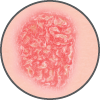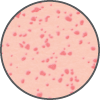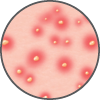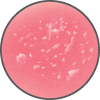About Psoriasis
WHAT IS PSORIASIS?
Psoriasis is a common but chronic skin condition that causes
inflammation and scaling (red elevated patches and flaking silvery
scales). The patches can be itchy or sore, causing discomfort and pain.
Psoriasis causes skin cells to rise to the surface and shed at a very
rapid rate. On average, people with psoriasis shed their skin cells
every 3 to 4 days, while people without the condition have a turnover
rate of about every 30 days.1,2,3,4
TYPES OF PSORIASIS
 |
Plaque – Plaque psoriasis is the most common form of the condition and affects about 90% of people living with psoriasis. It causes raised, red, dry lesions or plaques that dry and flake off. This type of psoriasis can affect any part of the body, but most often shows up on the scalp, elbows, knees, and lower back. |
 |
Guttate – Guttate psoriasis is the second most common form of the condition and affects about 10% of psoriasis sufferers. It is usually found in young adults and children and triggered by a bacterial infection like strep throat. It is characterized by small, drop-shaped lesions that appear on the trunk, arms, legs, and scalp. |
 |
Inverse – Inverse psoriasis is identified by smooth red lesions that may appear shiny. Inverse psoriasis shows up in the skin folds where there is friction and sweat, most commonly in the armpits, in the groin, around genitals, and under the breasts. Fungal infections can trigger this type of psoriasis. |
 |
Pustular – Pustular psoriasis typically causes small, pus-filled blisters which then dry out and form scales. The blisters, or pustules, can affect a small area of the body (localized), or a large one (generalized). If the condition is localized, pustules tend to be contained to the palms of hands or soles of feet. |
 |
Erythrodermic – Erythrodermic psoriasis is a rare but severe form of the condition that affects a large part of the body and causes a red, peeling rash. This form of the condition often has to be treated in the hospital. The skin loses its ability to perform vital functions like regulate the body’s temperature or protect against infection. |
WHO GETS PSORIASIS AND WHY?
 |
Scientists do not know exactly why people get psoriasis, but it seems to be linked to the immune system and genetics.3 People who have one parent with psoriasis have an increased risk of developing the condition, and the risk increases if both parents have it.7 |
 |
Psoriasis usually develops from ages 15 to 35, but it can appear in anyone, from infants (which is rare), to older adults.3 |
 |
People with psoriasis have an overactive immune system, causing T cells to attack healthy skin cells by mistake, instead of fighting off viruses or bacteria. These overactive T cells cause skin to turn over too quickly, and trigger psoriasis.6 |
 |
Men and women get psoriasis at about the same rates.2 Psoriasis affects individuals of all ethnicities, but Caucasians tend be affected at a slightly higher frequency (3.6%) than African Americans (1.9%).3 |
